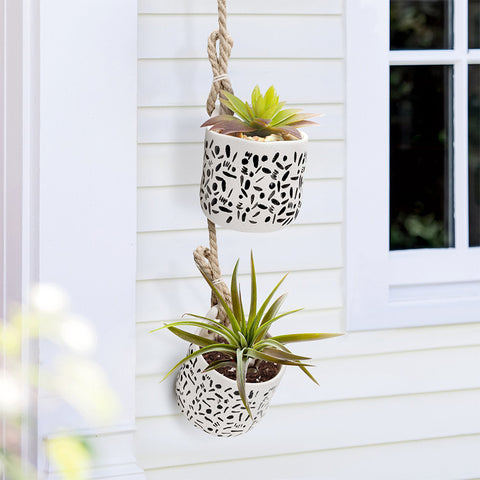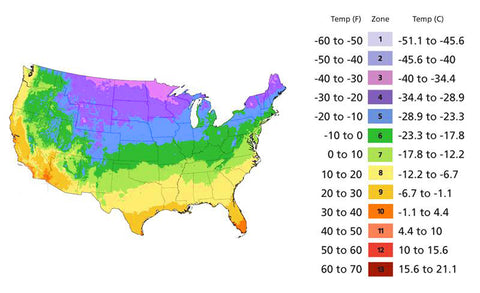String of Pearls is a cascading succulent that resembles a strand of pearls, except the 'pearls' are green. String of Pearls (Senecio Rowleyanus) is a low-maintenance plant that can be grown indoors or outdoors and will create a waterfall effect as it matures.

About The Plant
It is a creeping, perennial, succulent vine that is native to the dry climates of southwest Africa. In its natural environment the plant stems trail on the ground, taking root wherever the plant comes into contact with the soil.
String of Pearls forms a dense mat along the ground in its natural environment. When planted in a hanging planter the stems will spill over the sides and cascade downward. Each of the succulent's leaves looks like tiny, round, pale green pearls, and as they cascade over the rim of a hanging planter and sway in the wind, they appear to create a waterfall.

The succulent is also known as String of Peas, String of Beans, and Roseary Vine.
How Many Plants in One Pot?
A mature String of Pearls plant will be 1-2 feet long but not very wide. To create a waterfall effect and have a whole pot of this unique succulent, plant one succulent for every 4-inches of pot space.
For example, a 12-inch pot should have 3 String or Pearls plants planted around the edges of the planter. Place the plants 1-inch back from the rim and space them 4-inches apart. This will give each plant plenty of soil and space to grow while creating a dense cascade over the edge of the planter.
Growing Conditions
String of Pearls needs very little water and plenty of bright light for maximum growing conditions.
Ideal growing conditions for colder climates will allow the plant to be outdoors during the summer and bring it back indoors when the weather begins to cool down. When the plant is in an ideal growing condition, it will proliferate to form a cascading waterfall over the side of the planter.
String of Pearls will also bloom under the right growing conditions. Tiny white flowers with a scent like cinnamon will appear on the plant in spring. The fragrant blooms will last for one month. Reduce watering and keep the plant at a consistent temperature of 60 degrees F during winter to promote spring flowers.

Image Credit: reddit.com
Best Climates
In growing zones 9 or above, String of Pearls can be grown outdoors. However, in climates that have winter temperatures of 30 degrees F or lower, the plant is best grown as an indoor houseplant.
The plant is native to Africa's dry, arid climates and will thrive anywhere it's dry and warm.
Cities or states in America with the best climates for growing String of Pearls include Las Vegas, Nevada, Texas, Arizona, and parts of California. These cities and states are some of the driest and warmest in America, but that does not limit this succulent can be grown. It can be grown anywhere indoors and under the right conditions.

Image Credit: edenbrothers.com
Water
String of Pearls, like all succulents, do not need much water. They have fleshy leaves that store water, so they are drought tolerant and can go for two weeks without water.
Check the soil before watering. It should be dry 1/2-inch deep before watering. Only water the plant once a month during the wintertime. Once they are overwatered, you might need totake some steps immediately because they can still be saved if they haven't been overwatered for a long while.
Sunlight
String of Pearls needs 6-8 hours of bright, indirect sunlight each day. When growing the plant indoors, place it near a south, east, or west-facing window to receive bright natural light. Don't allow the plant to touch the window, and don't place it in direct sunlight.
If you don't have an indoor space that provides enough bright light naturally, use fluorescent or LED grow lights as a supplemental light source.
Air Temperature
The succulent thrive in a location that remains 70-80 degrees F in summer and around 60 degrees F in the winter. Keep the plant away from air and heating vents, open windows, and exterior doors. It does not like drafts or sudden temperature changes.
Humidity
Succulents like String of Pearls thrive in a dry environment and don't like humidity. Therefore, don't place this plant in a frequently used bathroom or near the kitchen sink where the humidity level is high. An average household humidity level of around 40% is ideal for this plant.
Soil
Plant String of Pearls in organic succulent soil formulated to grow succulents. It will contain a little sand to promote good water drainage and help keep plant roots on the dry side.
Fertilize
String of Pearls does not like to be fed. If you choose to provide the succulent, use only one-half the recommended amount of fertilizer and feed the plant only once a month during the summer.
Pot Size
Select a pot that provides 4-inches for each plant. If it is bigger, it will allow the soil to stay wet for too long, smaller, and won't let roots grow normally.
Select a terracotta or unglazed ceramic pot to provide the drainage the succulent needs.
Repoting
Repot the plant every 2-3 years when you notice that growth slows down or when the plant becomes root-bound. Repot the succulent into a slightly larger pot each time it's repotted. You might learn how to repot them here.

Conclusion
String of pearls is an easy-care succulent that can be grown indoors or outdoors. The cascading pearl-like leaves will form a waterfall effect as the plant grows.
Give the plant very little water, place it in a warm and bright location, and feed it sparingly. Repot every few years.
You might like the other succulents in the shape of string.

























